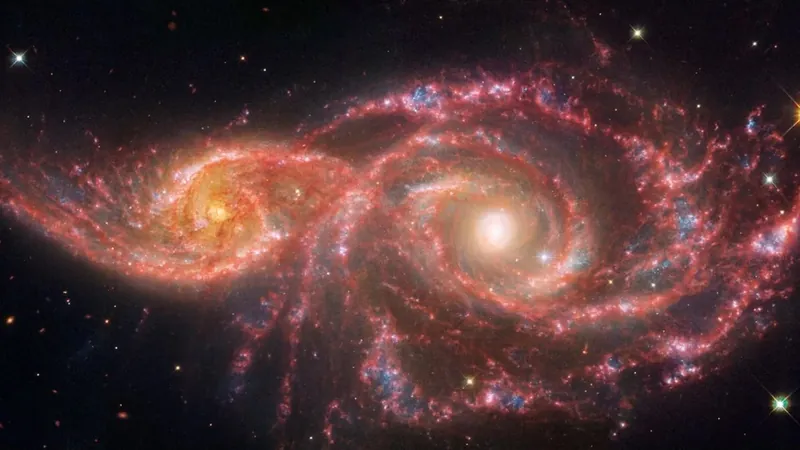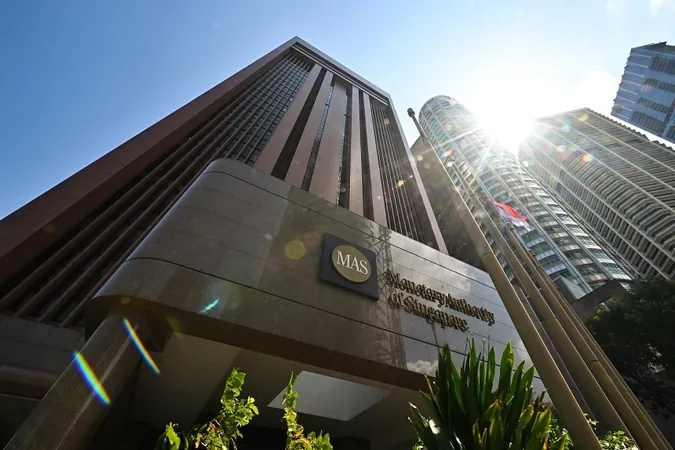
A Haunting Celestial Encounter: Unveiling the 'Bloodshot Eyes' of IC 2163 and NGC 2207
2024-11-17
Author: Daniel
In an enthralling cosmic display located 80 million light-years away in the Canis Major constellation, the spiral galaxies IC 2163 and NGC 2207 are captivating astronomers and stargazers alike. Recently shared on October 31, 2024, stunning images captured by the James Webb Space Telescope (JWST) and the Hubble Space Telescope depict this eerie pair with cores that evoke the haunting image of "blood-soaked" eyes, creating a mesmerizing visual narrative of their ongoing collision.
The two galaxies have been locked in a cosmic embrace for millions of years, with IC 2163, the smaller galaxy on the left, gradually drifting behind its larger counterpart, NGC 2207. This close interaction has forged unique and fascinating features in their structures. The galaxies' spiral arms now exhibit tail-like extensions—indications of gravitational forces at play—which are clearly illustrated in the image, alongside prominent bulging areas marked in vivid red.
Both IC 2163 and NGC 2207 are extraordinary stellar nurseries, churning out around 24 sun-like stars annually, significantly outpacing the Milky Way's average of just two to three new stars per year. This rampant star formation has been fueled by the aftermath of supernova events, with these galaxies recording seven known supernovas within recent decades. Each supernova explosion generates shockwaves that trigger new star formations by redistributing dust and gas throughout the galaxies’ spiral arms.
The magnificent image merges the mid-infrared data from JWST with the ultraviolet and visible-light observations from Hubble. Star-forming regions blaze in brilliant blues from Hubble’s visuals, contrasted by pink and white hues captured by JWST. Among these locations are super star clusters, which host compact groupings of stars, and areas identified as "mini-starbursts," where star formation is occurring at extraordinary rates.
What does the future hold for these cosmic neighbors? As eons pass, IC 2163 and NGC 2207 will orbit each other ever more closely, culminating in an eventual merger that will reshape their combined structure. This evolutionary dance will result in a singular galaxy boasting a unified, bright core and a new formation of spiral arms. However, don't expect to witness this transformation any time soon; it won’t be until approximately one billion years from now that the 'bloodshot eyes' of these galaxies meld into a singular entity—offering a glimpse into the dynamic, ever-evolving nature of our universe.
Stay tuned for more captivating cosmic stories as we continue to explore the wonders of our galaxy and beyond!


 Brasil (PT)
Brasil (PT)
 Canada (EN)
Canada (EN)
 Chile (ES)
Chile (ES)
 España (ES)
España (ES)
 France (FR)
France (FR)
 Hong Kong (EN)
Hong Kong (EN)
 Italia (IT)
Italia (IT)
 日本 (JA)
日本 (JA)
 Magyarország (HU)
Magyarország (HU)
 Norge (NO)
Norge (NO)
 Polska (PL)
Polska (PL)
 Schweiz (DE)
Schweiz (DE)
 Singapore (EN)
Singapore (EN)
 Sverige (SV)
Sverige (SV)
 Suomi (FI)
Suomi (FI)
 Türkiye (TR)
Türkiye (TR)